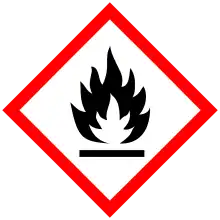| Names | |
|---|---|
| Preferred IUPAC name
Hept-1-ene | |
| Identifiers | |
3D model (JSmol) |
|
| ChemSpider | |
| ECHA InfoCard | 100.008.881 |
| EC Number |
|
PubChem CID |
|
| UNII | |
| UN number | 2278 |
CompTox Dashboard (EPA) |
|
| |
| |
| Properties[1] | |
| C7H14 | |
| Molar mass | 98.189 g·mol−1 |
| Appearance | Colorless liquid |
| Density | 0.697 g/mL |
| Melting point | −119 °C (−182 °F; 154 K) |
| Boiling point | 94 °C (201 °F; 367 K) |
| Hazards[1] | |
| GHS labelling: | |
   | |
| Danger | |
| H225, H304, H410 | |
| P210, P233, P240, P241, P242, P243, P273, P280, P301+P310, P303+P361+P353, P331, P370+P378, P391, P403+P235, P405, P501 | |
| Flash point | −9 °C (16 °F; 264 K) |
Except where otherwise noted, data are given for materials in their standard state (at 25 °C [77 °F], 100 kPa).
Infobox references | |
Heptene is a higher olefin, or alkene with the formula C7H14. The commercial product is a liquid that is a mixture of isomers. It is used as an additive in lubricants, as a catalyst, and as a surfactant. This chemical is also known as heptylene.
 A log-lin vapor pressure chart of Heptene compared with various liquids
A log-lin vapor pressure chart of Heptene compared with various liquids
References
- 1 2 1-Heptene at Sigma-Aldrich
Further reading
- Carl Schaschke, 2014, A Dictionary of Chemical Engineering, Oxford University Press.
- G. I. Nikishin, Yu. N. Ogibin & L. Kh. Rakhmatullina, 1975, ‘Peroxydisulfate-initiated reactions of 1-heptene with acetic and propionic acids’, Bulletin of the Academy of Sciences of the USSR, Division of chemical science, volume 23, pages1479–1483
- Yu. D. Shenin, T. V. Kotenko & A. N. Egorenkova, Nystatin. IV. 1969, The heptaene component of samples of nystatin-nursimicin, Pharmaceutical Chemistry Journal volume 3, pages 631–634
- Nicholas E. Leadbeater, Cynthia B. McGowan, 2013, Experiment 2: Second-Order Elimination Reaction Preparation of Heptene from 2-Bromoheptane, Laboratory Experiments Using Microwave Heating, chapter 3
- E. S. Mortikov, M. I. Rozengart & B. A. Kazanskii, 1968, Dehydrocyclization of n-heptenes under conditions of a pulsed system and in the usual flow-type setup, Bulletin of the Academy of Sciences of the USSR, Division of chemical science volume 17, pages95–98(1968)
This article is issued from Wikipedia. The text is licensed under Creative Commons - Attribution - Sharealike. Additional terms may apply for the media files.